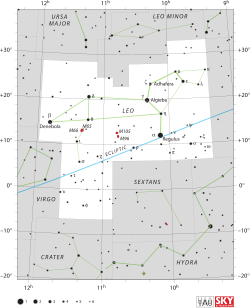Chi Leonis
| Chi Leonis (χ) | |
 | |
| Observationsdata Epok: J2000.0 | |
|---|---|
| Stjärnbild | Lejonet |
| Rektascension | 11t 05m 01,02754s[1] |
| Deklination | +07° 20′ 09,6235″[1] |
| Skenbar magnitud () | +4,63[2] |
| Stjärntyp | |
| Spektraltyp | F2 III-IVv[3] |
| U–B | +0,06[2] |
| B–V | +0,33[2] |
| Astrometri | |
| Radialhastighet () | +4,7[4] km/s |
| Egenrörelse (µ) | RA: -344,28[1] mas/år Dek.: -47,65[1] mas/år |
| Parallax () | 34,49 ± 0,20[1] |
| Avstånd | 94,6 ± 0,5 lå (29,0 ± 0,2 pc) |
| Absolut magnitud () | 2,31[5] |
| Detaljer | |
| Massa | 1,62[6] M☉ |
| Radie | 1,99[7] R☉ |
| Luminositet | 9,9[5] L☉ |
| Temperatur | 7 022 ± 80[6] K |
| Metallicitet | +0,03[6] dex |
| Vinkelhastighet | 25 ± 1[3] km/s |
| Ålder | 1,40[6] miljarder år |
| Andra beteckningar | |
| χ Leo, 63 Leonis, BD+08° 2455, FK5 418, HD 96097, HIP 54182, HR 4310, SAO 118648. [8] | |
Chi Leonis (χ Leonis, förkortat Chi Leo, χ Leo) är en trolig dubbelstjärna[9] belägen i den södra delen av stjärnbilden Lejonet. Den har en skenbar magnitud på 4,63[2] och är synlig för blotta ögat där ljusföroreningar ej förekommer. Baserat på parallaxmätning inom Hipparcosuppdraget på ca 34,5[1] mas, beräknas den befinna sig på ett avstånd på ca 95 ljusår (ca 29 parsek) från solen.
Egenskaper[redigera | redigera wikitext]
Primärstjärnan Chi Leonis A är en gul till vit jättestjärna av spektralklass F2 III-IVv[3]. Den har en beräknad massa som är ca 60 procent[6] större än solens massa, en radie som är nästan dubbelt så stor[7] som solens och utsänder från dess fotosfär ca 10[5] gånger mera energi än solen vid en effektiv temperatur av ca 7 000[6] K.
Följeslagaren är en stjärna av 11:e magnituden med en vinkelseparation av 4,1 bågsekunder vid en positionsvinkel av 264°, år 1990.[10]
Referenser[redigera | redigera wikitext]
- Den här artikeln är helt eller delvis baserad på material från engelskspråkiga Wikipedia, tidigare version.
Noter[redigera | redigera wikitext]
- ^ [a b c d e f] van Leeuwen, F. (2007), "Validation of the new Hipparcos reduction", Astronomy and Astrophysics, 474 (2): 653–664, arXiv:0708.1752, Bibcode:2007A&A...474..653V, doi:10.1051/0004-6361:20078357.
- ^ [a b c d] Mermilliod, J.-C. (1986), Compilation of Eggen's UBV data, transformed to UBV (unpublished), SIMBAD, Bibcode:1986EgUBV........0M.
- ^ [a b c] Royer, F.; et al. (October 2002), "Rotational velocities of A-type stars in the northern hemisphere. II. Measurement of v sin i", Astronomy and Astrophysics, 393: 897–911, arXiv:astro-ph/0205255, Bibcode:2002A&A...393..897R, doi:10.1051/0004-6361:20020943.
- ^ Wilson, R. E. (1953), General Catalogue of Stellar Radial Velocities, Carnegie Institute of Washington, D.C., Bibcode:1953GCRV..C......0W.
- ^ [a b c] Anderson, E.; Francis, Ch. (2012), "XHIP: An extended hipparcos compilation", Astronomy Letters, 38 (5): 331, arXiv:1108.4971, Bibcode:2012AstL...38..331A, doi:10.1134/S1063773712050015.
- ^ [a b c d e f] Casagrande, L.; et al. (2011), "New constraints on the chemical evolution of the solar neighbourhood and Galactic disc(s). Improved astrophysical parameters for the Geneva-Copenhagen Survey", Astronomy & Astrophysics, 530 (A138): 21, arXiv:1103.4651, Bibcode:2011A&A...530A.138C, doi:10.1051/0004-6361/201016276.
- ^ [a b] Rachford, Brian L.; Foight, Dillon R. (June 2009), "Chromospheric Variability in Early F-Type Stars", The Astrophysical Journal, 698 (1): 786–802, arXiv:0904.1620, Bibcode:2009ApJ...698..786R, doi:10.1088/0004-637X/698/1/786.
- ^ "* chi Leo". SIMBAD. Centre de données astronomiques de Strasbourg. Hämtad 2016-09-29.
- ^ Eggleton, P. P.; Tokovinin, A. A. (September 2008). "A catalogue of multiplicity among bright stellar systems". Monthly Notices of the Royal Astronomical Society. 389 (2): 869–879. arXiv:0806.2878. Bibcode:2008MNRAS.389..869E. doi:10.1111/j.1365-2966.2008.13596.x.
- ^ Mason, B. D.; et al. (2014), "The Washington Visual Double Star Catalog", The Astronomical Journal, 122: 3466–3471, Bibcode:2001AJ....122.3466M, doi:10.1086/323920.





